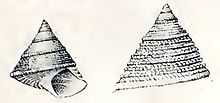Clelandella miliaris
| Clelandella miliaris | |
|---|---|
 | |
| Drawing with two views of a shell of Clelandella miliaris | |
| Scientific classification | |
| Kingdom: | Animalia |
| Phylum: | Mollusca |
| Class: | Gastropoda |
| Clade: | Vetigastropoda |
| Superfamily: | Trochoidea (superfamily) |
| Family: | Trochidae |
| Genus: | Clelandella |
| Species: | C. miliaris |
| Binomial name | |
| Clelandella miliaris (Brocchi, 1814)[1] | |
| Synonyms[2] | |
| |
Clelandella miliaris is a species of sea snail, a marine gastropod mollusk in the family Trochidae, the top snails.[2]
Description
The size of the shell varies between 7 mm and 18 mm. The imperforate, rather thin, but pretty solid shell has a strictly conical shape. It is whitish or yellowish, with more or less obvious longitudinal flames, often reduced to a few spots on the ribs and a row of spots at the periphery of each whorl. The surface is densely finely sculptured by spiral lirae crossed by very regular oblique lamellae, producing a clathrate pattern. The spiral lirae number about 6 on each whorl, but often double as many, by the intercalation of riblets in the interstices. The periphery has a prominent keel, cord-like, with secondary spiral striae, or bifid, cut into compressed granules, somewhat prominent above the sutures. The base has about 8 concentric ribs. The interstices are radiately striate, sometimes with a central riblet. The spire has a conical shape with about 7 whorls. The periphery is acutely angled. The base of the shell is flat. The aperture is quadrangular. The short columella is nearly straight. [3]
Distribution
This marine species has a wide distribution. It occurs off Lofoten Islands, the North Sea (Norway to Gibraltar), off Cape Verde Islands, West Sahara and Mauritania; in the Mediterranean Sea and the Adriatic Sea. In the Baltic Sea it has become a vulnerable species.[4]
References
- ↑ Brocchi G. B. (1814). Conchiologia fossile subappenninica con osservazioni geologiche sugli Appennini e sul suolo adiacente. Milano Vol. I: pp. LXXX + 56 + 240; Vol. II, p. 241-712, pl. 1-16. World Register of Marine Species, Retrieved 1 May 2010.
- ↑ 2.0 2.1 Clelandella miliaris (Brocchi, 1814). Gofas, S. (2009). Clelandella miliaris (Brocchi, 1814). In: Bouchet, P.; Gofas, S.; Rosenberg, G. (2009) World Marine Mollusca database. Accessed through: World Register of Marine Species at http://www.marinespecies.org/aphia.php?p=taxdetails&id=141774 on 5 September 2010.
- ↑ Tryon (1889), Manual of Conchology XI, Academy of Natural Sciences, Philadelphia (described as Calliostoma miliaris)
- ↑ HELCOM (2013). "HELCOM Red List of Baltic Sea species in danger of becoming extinct". Baltic Sea Environmental Proceedings (140): 66.